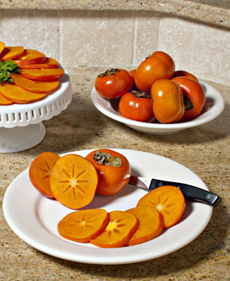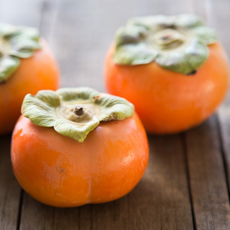TIP OF THE DAY: Winter Fruit Substitutes

|
Eating seasonally, a practice that has always existed in culinary meccas like France and Italy (and existed everywhere by default prior to modern transportation and food technology), is an idea that’s been promulgated for some 40 years in the U.S., first by chef and restaurateur Alice Waters. The the “farm-to-table” movement and subsequent awareness of sustainability and carbon miles continue to underscore the need to change the on-demand desires of American consumers. Some do better when frozen than others, and fruits, frozen at their peak, are an option. But if you want fresh-to-fresh, here are some good substitutes: |
|
|
SUBSTITUTE PERSIMMONS FOR TOMATOES Perhaps the most missed fruit or vegetable is the fresh tomato, a staple of salads and sandwiches. Hannah Kaminsky of Bittersweet Blog, residing in the produce capital of America, writes: “Even in balmy California, farmers market tables once straining under the weight of plump tomatoes and juicy peaches look comparatively sparse, bearing dusty tubers and hearty greens instead. “I’d never dream of making classic tabbouleh† in winter, when only mealy tomatoes shipped halfway across the globe can be found in markets.” Her solution: Substitute persimmons for bland imported tomatoes. The recipe is below. “It makes perfect sense the moment you taste the persimmons in this light salad” Hannah notes. “Their juicy, meaty texture and natural sweetness are an excellent substitution.” She adds even more seasonal produce to the standard tabbouleh recipe: “Pomegranate arils lend tart, crunchy bursts of flavor. And while parsley could be the sole herbaceous element, I felt compelled to toss in those unloved green carrot tops that are all too often discarded, rather than savored as they should be.” |
||
|
RECIPE: WINTER TABBOULEH Ingredients For 4-6 Servings 1. COMBINE the bulgur, turmeric and vegetable broth in a small saucepan and place over low heat. Stir well and bring to a boil. Cover, turn off the heat, and let stand for 15-20 minutes until all of the liquid has been absorbed. Let cool slightly. Meanwhile… |
|
|
|
2. PREPARE the fruits and vegetables accordingly, and toss them together in a large bowl. Add the cooled bulgur, followed by the lemon juice, olive oil, salt and pepper. Taste and adjust flavors according to personal preference. 3. COVER and chill for at least 2 hours before serving to allow the flavors to marry. In the late 1880s, the first persimmon arrived in the U.S., brought by a naval commander returning to Washington D.C. from Japan. Here’s more about persimmons, including how to enjoy them at every meal of the day. †Classic tabbouleh ingredients are bulgur wheat, parsley, tomato and onion, dressed with olive oil and lemon juice. |
||




